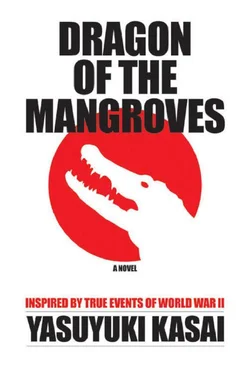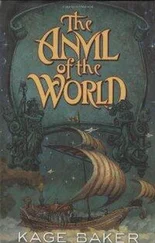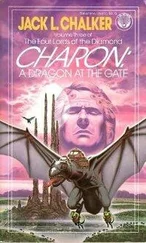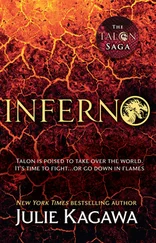Yoshitake said cheerfully, “What a blessing! A cigarette is a good sleeping pill for me. Now, start your pillow talk, Pondgi.”
Pondgi wasn’t good at articulating complex topics such as ecology or biology.
However, Morioka, who was versed in animals, came to his rescue. Having regained their composure, the other soldiers listened as they relaxed.
Saltwater crocodiles live widely in the tropics, from eastern India to the western Pacific, and prefer relatively tranquil water, whether in the river or in the sea.
They are gigantic, as Morioka said—maybe the biggest reptile of them all. The croc naturally reigns at the top of the food hierarchy. Although fundamentally a solitary animal, crocodiles sometimes herd together in between breeding seasons.
They say a crocodile has acute senses of sight and hearing. The pupil of its eye is set vertically like a cat’s. It can see prey in dead darkness and is sharp-nosed, as well. It is easy for a crocodile to smell faint scents of blood far away, so it can locate other animals even in muddy water with poor visibility.
A crocodile fixes its aim and skillfully hides its huge trunk under water, leaving only its eyes and nostrils inconspicuously on the surface. Then it approaches its prey slowly and silently. Once the prey enters the effective range, the crocodile pounces upon it with lightning speed. The power of its jaws is enormous. It can crush the skulls of cattle easily. If the croc doesn’t kill its prey on the spot, it immediately drags the prey into the water and suffocates it.
Quite contrary to its gigantic body, its stomach is small. A crocodile can’t swallow its prey in one gulp like a snake does. It drags the kill to a favorite place and hides it there. Then it savors the half-rotten meat bit by bit, leisurely tearing it off with sharp teeth. Though the kill is hidden, in the case of a big carcass, its odor and blood soon attract other crocodiles, creating a herd. As they rush at the prey and fall over one another, it causes quite a commotion. However, it’s not a hindrance for them all. It is often preferable to tear off pieces while the prey is held firmly on the other side. So these banquets hardly develop into scuffles.
They say that locals in the coastal area of Burma often disappear abruptly while scrubbing or washing. More than a few incidents happen every year. They vanish suddenly in most cases, although body parts of the missing persons are found later, torn unpleasantly on some occasions. Locals believe this is the work of crocodiles.
Pondgi said his uncle had been missing for three years after having gone to a mangrove near Sandoway to set weirs. All the family had gone out to search for him many times, but the only thing they had ever found was his masterless sampan adrift on a creek.
This was all quite inappropriate for pillow talk. Sumi was overwhelmed by the fact that such formidable animals inhabited the Burmese waterfront.
As Shimizu said, the Army usually didn’t fear crocodiles and other animals; their purpose was to murder troops. Compared with modern weapons, which could burn up a city in an instant, an animal was next to nothing, however fierce it might be. When this war broke out, soldiers were more ferocious than now.
Some might have wanted to kill a croc and eat it if things hadn’t changed. But now the whole situation had changed completely.
Enemies cornered them with material superiority. Starvation and fatigue gnawed at every soldier not issued enough weapons to defend himself. Darkness and only a few geographic advantages were all the refuges left for the Japanese, but their soldiers truly controlled neither.
Sumi recalled Sebek again.
4

Minoru Kasuga was dreaming of a day when he had been a schoolboy. He had been playing with his friends at a Hachiman shrine after school, as usual.
His hometown had a splendid shrine surrounded by tall cedars. It even had a hall for Noh performance in the precinct. Locals not only respected it as a religious institution but utilized it as a festive center of their community. For chil-dren, it was their favorite playground. They used to spend time there until sunset, playing every kind of game like tag or hide-and-seek.
In the dream, he had brandished a twig like a sword and had run after one of his schoolmates. They had played swashbuckling ninja. But his friends had disappeared from view, one by one, as if they had become real ones. And he had been left alone at dusk. Feeling uneasy, he had walked along to the shrine.
To a lone child, the presence of the shrine and the holy territory had been getting stronger than ever. And the shrine had one thing that had always frightened him.
The shrine was reportedly built in the latter period of the Tokugawa, a medi-eval time of samurai governance. It had many reliefs under its eaves. Mythologi-cal sacred animals, such as Chinese lions and phoenixes, had been splendidly carved. A dragon on the front architrave was a true masterpiece among them. A carver of considerable ability must have made it.
But it had scared him. He had understood it was merely an imaginary creature carved out of wood. Yet it had been so lifelike to his eyes that he couldn’t help feeling it real.
He had fearfully looked up the architrave. The dragon had been there as usual.
Clad in whiffs of clouds, it had clawed the air with its sharp, pointed talons. It had been a monster. Its iris-less eyes had appeared to shine, in spite of its natural wood surface. Its nostrils had seemed ready to steam at any moment.
He had gradually been possessed by a delusion that the dragon might come out of the relief. If it happened, the dragon would kill him and tear his body to pieces on the spot.
Unfathomable fear had begun gnawing at him. The harder he had tried to control his increasing pulse rate, the more alive the dragon had become, as if it read his thoughts. Suddenly, he had come to believe it was not a delusion anymore, but a sheer reality.
The scales that had never been anything more than a wooden crafted work had trembled. The cloud twining around its four limbs had become translucent and emitted white, hazy light. Then, he had been astounded to see the long, stout tail wiggle.
A real dragon must have waited in the shape of the relief to catch some prey here. After seeing him, it must have been revealing its true colors. He had immediately tried to run away, but his feet had disobeyed his will and hadn’t moved, as if nailed on the ground.
All of a sudden, he had heard a strange voice, deep and serene: “Don’t be afraid. A dragon surely looks fierce. But it is Buddha’s vassal chastising evil.”
When he had looked again, the dragon had lost its shine. It had had no vitality at all. It had been nothing more than a weathered, musty relief. He had breathed easily again and looked around. The evening twilight had been gradually surrounding the shrine, as usual. It had almost been time to go home. Relieved from fear, he had become thirsty. He had strolled down the approach and headed for a water fountain beside the gate.
The donator of this shrine had most likely been a considerable dragon lover.
The spout of the fountain was also a dragon’s head. It was a cast statue full of ver-digris. Clear water had trickled ceaselessly from it into the basin.
He had picked up one of wooden dippers from the basin. Right at the moment he had begun filling it with water, he had seen the statue open its eyes.
Both had glittered in pure gold. Then he had sensed the dipper taken violently from his hand. When he flinched and drew back a few steps, it had no longer been a statue. A long trunk had appeared from the rock base of the spout and had wriggled to get out of it. Its innumerable scales had emitted a pale green light.
Читать дальше













